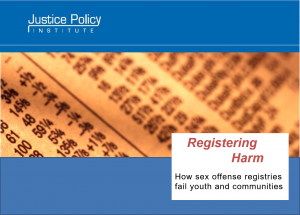Social Science, Criminal Justice, and Sex Offender Reform
Studies from around the web
“Frightening and High” The Supreme Court’s Crucial Mistake About Sex Crime Statistics
By Ira Mark Ellman and Tara Ellman 2015
In McKune v. Lile, 536 U.S. 24,33 (2002), the Supreme Court reversed two lower courts in rejecting, 5-4, Robert Lile’s claim that Kansas violated his 5th Amendment rights by punishing him for refusing to complete a form detailing all his prior sexual activities, including any that might constitute an uncharged criminal offense for which he could then be prosecuted. The form was part of a prison therapy program that employed a polygraph examination to verify the accuracy and completeness of the sexual history which program participants were required to reveal.
Grand Challenges: Social Justice and the Need for Evidence-based Sex Offender Registry Reform
Grand Challenges: Social Justice and the Need for
Evidence-based Sex Offender Registry Reform
Sex offender registries, though popular, bring with them enormous fiscal costs and unintended consequences for offenders and communities. Consistent with the Grand Challenges, social workers can play a role in advocating for sex offender management policies that are better informed by evidence and thus a better use of resources.
Regulating Sexual Harm: Strangers, Intimates, and Social Institutional Reform
Regulating Sexual Harm: Strangers, Intimates, and Social Institutional Reform
The criminal regulation of sexual harm in the United States is afflicted by deep pathology. Although sexual harm appears before the law in a variety of forms—from violent rape, to indecent exposure, to the sexual touching by an older child of a younger child—the prevailing U.S. criminal regulatory framework responds to this wide range of conduct with remarkable uniformity. All persons so convicted are labeled “sex offenders,” and most are subjected to registration, community notification, and residential restrictions, among other sanctions.
Exit From the Sex Offender Registries
Exit From the Sex Offender Registries
This Article examines a particular outgrowth of this survival story, one directly affecting both the number of individuals on registries and their onerous quality: the extent to which registrants are provided an opportunity to exit registries. As will be discussed, individuals very often face a lifetime of registration requirements and community notification—a perpetual “rogues’ gallery.”17 If not, in the absence of their conviction being reversed or a gubernatorial pardon being granted (today a rare occurrence)18—and sometimes not even then 19—individuals typically remain on registries for a minimum of 10 and up to 40 years. This is so regardless of whether or not they have been convicted of another crime (sexual or otherwise) and their future likelihood of recidivism.
Assessment of Sex Offender Notification Policy in the Unites States: Has the Policy Been Working
Assessment of Sex Offender Notification Policy in the Unites States: Has the Policy Been Working
It has been almost 10 years since the policies were introduced in the United States. Over the past decade, researchers have discussed various aspects of these policies, such as legal concerns and effectiveness of the policies. In this report, we will review the recent studies regarding the policies to evaluate whether the Sex Offender Registration and Notification policies have been effective as it originally intended to achieve. In order to examine the policies thoroughly, we applied four concepts of assessing the policy – Theory, Marketing, Implementation, and Self-Reflection – from the book Trial & Error in Criminal Justice: Learning from Failure by Berman and Fox. Moreover, we discuss potential directions for future sex offender policy reform.
The Good, the Bad, and the Incomprehensible: Typifications of Victims and Offenders as Antecedents of Beliefs About Sex Crime
Drawing on recent national survey data, we examine the extent to which typifications about sexual victims and offenders—elieving sex crime typically affects children and female victims and is committed by strangers—explain beliefs about the reformability of sex offenders, harm inflicted on victims, and the causes of offending. Results indicate that judging children to be typical targets of sex crimes is a key determinant of public views. We discuss the implications of our findings.
Law Enforcement Perspectives on SORNA
Law Enforcement Perspectives on SORNA
Research Question 1: What do law enforcement professionals view as the primary functions and purposes of SORN systems?
Research Question 2: How do law enforcement professionals view the efficacy of current SORN systems in fulfilling those functions and purposes, and what are the primary barriers to effectiveness?
Research Question 3: What recommendations do law enforcement professionals have for improving SORN policy and practice?
Research Question 4: Concerning the above-referenced issues, how do the views of agency leadership align with or differ from those who are on the front lines of SORN system operations and enforcement?
Paying the Piper: The Cost of Compliance with the Federal Sex Offender Registration and Notification Act
Every piece of sex offender legislation has a compelling political backstory. No different is the Sex Offender Registration and Notification Act of 2006 (SORNA), which aims to build a comprehensive national sex offender registry in the United States. However, lost in the passionate determination to eliminate sexual crime is a rational cost-benefit analysis of state compliance. This note describes the long-standing problem of compliance with SORNA and identifies cost as a key contributor to state noncompliance. With the principal purpose of SORNA in mind, this note then proposes different approaches to addressing the financial barriers to SORNA and valuates each response in light of compliance. Ultimately, this note calls for a change of focus in the way that politicians and legislators look at implementing SORNA, as well as other sex offender legislation in the United States.
Registering Harm: How Sex Offense Registries Fail Youth and Communities
Justice Policy Institute

Regarding Cost
During this time of budget shortfalls, states should consider all possible areas in which increased expenditures will occur.
- New personnel to register more people more often, collect information, make updates, etc.
- Software, including installation, maintenance, and technical support
- Additional jail and prison space for people who fail to register
- Court and administrative costs related to reclassification due to the retroactivity clause of the AWA
- Law enforcement costs related to tracking down people who fail to register
- Legislative costs related to adopting and crafting state law
The Adam Walsh Act: An Examination of Sex Offender Risk Classification Systems

The Adam Walsh Act: An Examination of Sex Offender Risk Classification Systems
This study was designed to compare the Adam Walsh Act (AWA) classification tiers with actuarial risk assessment instruments and existing state classification schemes in their respective abilities to identify sex offenders at high risk to re-offend…
Actuarial measures and existing state tier systems, in contrast, did a better job of identifying high-risk offenders and recidivists…
The results indicate that the AWA sex offender classification scheme is a poor indicator of relative risk and is likely to result in a system that is less effective in protecting the public than those currently implemented in the states studied.
Testing the sexually abused-sexual abuser hypothesis: A prospective longitudinal birth cohort study
Testing the sexually abused-sexual abuser hypothesis
Australian academic study of childhood sexual abuse victims and their propensity to abuse as adults.
The sexually abused-sexual abuser hypothesis posits that persons, especially males, who are sexually abused as children are at particular risk of sexually abusing others later in life. We tested this hypothesis by prospectively examining associations between maltreatment and offending in a birth cohort of 38,282 males with a maltreatment history and/or at least one finalized offense. We examined these associations within the context of the wider birth population. Proportionally few boys were the subject of official notifications for sexual abuse (14.8% of maltreated boys, and 1.4% of the birth population); proportionally very few of these sexually abused boys (3%) went on to become sexual offenders; and, contrary to findings typically reported in retrospective clinical studies, proportionally few sexual offenders (4%) had a confirmed history of sexual abuse. Poly-victimization (exposure to multiple types of maltreatment) was significantly associated with sexual offending, violent offending, and general (nonsexual, nonviolent) offending. We found no specific association between sexual abuse and sexual offending, and nor did we find any association between sexual abuse and sexual offending specifically within the poly-victimized group. The total number of sexual abuse notifications did make a small unique contribution to the variance in sexual offending compared to other offending. Implications concerning maltreated boys and male sexual offenders are discussed.
© 2015 Published by Elsevier Ltd.
Does Residential Proximity Matter? A Geographic Analysis of Sex Offense Recidivism?
A Geographic Analysis of Sex Offense Recidivism
Prior research has clearly indicated that sex offenders are, compared to other offenders, among the least likely to reoffend (Harris & Hanson, 2004; Langan & Levin, 2002; Sample & Bray, 2006). Moreover, when sex offenders recidivate, they are much more likely to do so with a nonsexual offense.
Recent research has shown that sex offenders—at least those who have been previously identified, convicted, and placed on sex offender registries—are likely to live in certain types of locations. Specifically, registered sex offenders are especially likely to live in neighborhoods that have high levels of social disorganization, greater proportions of youth, and lower proportions of high school and college graduates, more minorities, fewer owner-occupied homes, and lower housing values and household incomes (Mustaine, Tewksbury, & Stengel, 2006a, 2006b, in press); these factors are especially salient for African American sex offenders. Most also live in single family homes but do not live in neighborhoods with a posted neighborhood watch (Tewksbury & Mustaine, 2006).
© 2008 International Association for Correctional and Forensic Psychology
“They’re Planting Stories In The Press”: The Impact of Media Distortion on Sex Offender Law and Policy
The Impact of Media Distortions on Sex Offender Laws
By Heather Ellis Cucolo and Michael L. Perlin 2013
The public perception of what constitutes a “sex offender” is undoubtedly linked to the media’s portrayal of these types of heinous crimes. The media’s attention to high profile, violent sexual offenses has been shown to elicit a panic and fear of rampant sexual violence within our communities. This, in turn, places extreme public pressure on legislators to enact more repressive legislation and on judges to interpret such laws in
ways that ensure lengthier periods of incarceration for offenders. The media’s portrayal of a “largely ineffective” criminal justice system heightens fear; fictionalized portrayals of crime on television dramas may lead viewers to believe that “all offenders are ‘monsters’ to be feared.” The media, in short, shapes and produces the reality of crime, as it influences “factual perceptions of the world.”
Clearly, much of the initial push to contain, confine and monitor offenders, over the last several decades, has, at the least, been partially motivated by the availability of mass media information and the media’s persistent display and interpretation of shocking and newsworthy sex crimes. It cannot be denied that moral panic is the progenitor of the resulting laws, and therefore the catalyst that spawned the political motivations that led to an outcry for stricter sex offender laws and legislation.
